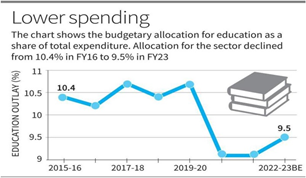

1st February 2023 (7 Topics)
Context
The budgetary allocation for education as a percentage of total expenditure has dropped over the past seven years, from 10.4% to 9.5%, according to the Economic Survey 2022-23.
Estimates of the survey:
- Based on Expenditure: While the expenditure on social services increased from ?9, 15,500 crore to ?21, 32,059 crore, the share of education within this umbrella category shrank from 42.8% to 35.5% between the financial years 2015-2016 and 2022-2023.
- The Budgetary estimates: The share of education in total expenditure declined from 10.7% in 2019-2020 to 9.1% in the first COVID year and remained stagnant in the following year, before being raised to 9.5% in the budgetary estimates for 2022-2023.
- As a share of total GDP: The budgetary allocation for education saw only a minimal gain of 0.1 percentage points, from 2.8% to 2.9% during the same seven year period.

Key highlights of Education sector:
- In Primary classes: For the year 2019-2020, the total dropout rate in primary school was 1.5%, which fell to 0.8% in 2020-2021, but rose back to 1.5% in 2021-2022.
- However, this is significantly better than the 4.7% dropout rate in 2013-2014.
- In upper primary classes: The dropout rate fell from 2.6% in 2019-2020 to 2.3% the following year, but rose to 3% in 2021-2022, only marginally lower than the 3.1% level seen in 2013-2014.
- In the secondary classes: The situation has steadily improved, with the dropout rate falling from 16.1% in 2019-2020 to 14% the following year and 12.6% last year.
- Total number of schools: Between 2013-2014 and 2021-2022, the total number of schools declined from 15.2 lakh to 14.9 lakh, with primary and upper primary schools seeing a reduction of one lakh schools to 11.9 lakh, though the number of secondary and senior secondary schools rose by 60,000 to a total of 2.3 lakh.
- For Higher education:
- The number of medical colleges in the country increased from 387 in 2014 to 648 in 2022, and the number of MBBS seats have increased from 51,348 to 96,077, although the report did not provide data segregated for public and private medical colleges.
- The number of Indian Institutes of Technology (IITs) rose from 16 to 23 between 2014 and 2022 and Indian Institutes of Management (IIMs) increased from 13 to 20.
- In 2014, there were 723 Universities in the country, which have increased to 1,113.
- The total enrolment in higher education has increased to nearly 4.1 crore in financial year 2020-21 from 3.9 crore in 2019-20.
- In 2021-2022, distance education saw a 7% growth over the previous year, with 45.7 lakh students enrolling.
|
Constitutional provisions regarding ‘education’ Till 1976, education was sole responsibility of state but constitutional amendment made it ‘concurrent subject’. Fundamental Rights
|
Challenges in the Education sector
- India has the third largest higher education system in the world, and is behind only the US and China.
- Higher educational institutions churn out around 2.5 million graduates every year. However, this caters to just about 10 per cent of India’s youth and the quality of this output is considered below par.
- Education reforms are focused mostly on inputs rather than learning outcomes as the performance of schools is assessed only by infrastructure and midday meals.
- This has been one of scathing criticism of Sarva Shiksha Abhiyan.
- Also, teachers tasked with raising student standards are burdened with administrative tasks. Budgetary constraints and lack of manpower and technological resources are other barriers.
- As a result, schools resort to rote-learning techniques to cope up with the mounting performance pressures.
More Articles


